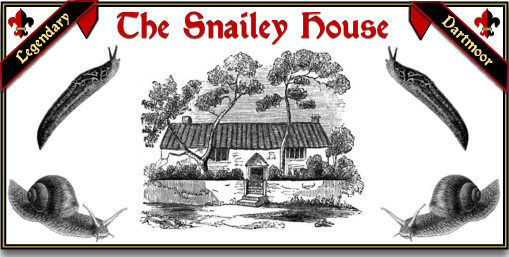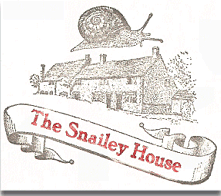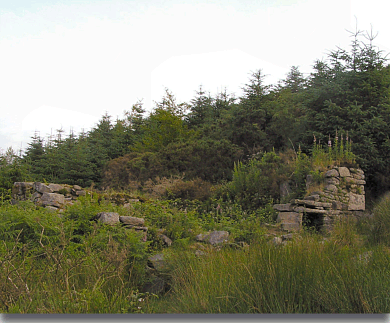
There once was a small cott nestled in the valley between Riddon Ridge and Bellever tor. The East Dart river ran close by the homestead which was known as Whiteslade or more appropriately the ‘Snailey House’. Now for some unknown reason, on Dartmoor a ‘snail’ is what is more commonly known as a slug so really it should have been called the ‘Slug House’. But how did it get such a strange name? There once lived at the house two old sisters who as far as the locals were concerned proved some what of a mystery. There was no doubt that they were poor, the house had fallen into neglect, the garden was overgrown with weeds and they kept no livestock, not so much a hen. But they always looked healthy, in fact some would say too healthy, others called them “praper Devon dumplins”. So where did they get their bounteous supply of food from? This puzzle came too much for the locals and so one night as dimpsey came some of the braver ones crept up to the cott and peeked in through the window. Much to their disgust they saw the answer to the puzzle for sat around the table were the two old women eating their dinner which consisted of ‘snails’, each had a huge plateful of big, black, slimy ‘snails’. What made is worse was that they were actually enjoying the disgusting meal. Apparently ‘snails’ are very nutritious and there are certainly plenty of them to be found on the moor grasses, so that was how the two old women kept body and soul together. From that day onwards Whiteslade became known as the ‘Snailey House’.
A few years later one of the old women died and left the other in a bad way. They could hardly look after the place when there was two of them but now there was only one it would be impossible. The local moorfolk expected the old lady to sell up and move off the moor but much to their amazement this didn’t happen. Unknown to anybody the old lady had two nieces living in Teignmouth and so she wrote and asked them to move up to the moor and help look after the homestead, and this they willingly agreed to do.
Having got to Ashburton the two nieces, Joan and Jane then faced the problem of getting up on the moor. As luck would have it a local moorman was in the town and heard of their plight. Gallantly he offered them a lift in his cart which they gladly accepted. The trip up on to the moors was perfect, it was as if Old Crockern had dressed the Dartmoor in its finest regalia, they could see for miles and the air was as pure as ever could be. The yellow of the gorse and mauve of the heather just added a riot of colour to the landscape. The two girls just grinned from ear to ear. Once on the level the old cart pretty sped along and the driver, Joe Leaman, started chatting. It took a while for the girls to get adjusted to his dialect but then they got on fine. They told Joe they were going up to look after an aged aunt who lived over by Bellever. Now this was Joe’s stamping ground so he enquired where the old maid lived and they happily offered “Whiteslade”.
Poor Joe nearly fell out the cart, he was dumbstruck, how could two such lovely girls be any kin of the snail eating women of the snailey House. He was in a right quandary now, should he tell them the truth or let them find out for themselves. In the end proper Dartmoor honesty won through, he stopped the cart and gently broke the bad news. At first they refused to believe him and were about to jump off the waggon when Joe pointed out that if it were not true what would be the point of making up such an unbelievable tale. The rest of the journey was in complete silence. Eventually they reached Whiteslade and it was clear the two girls were in two minds whether to stay or go. Jane reminded Joan that it was family and that’s all that mattered and so they clambered out of the cart and marched up to the door.
Now it did not take the girls long to discover that the moorman was telling the truth because in the pantry they found earthen jars full of live black slimy ‘snails’ and others with dry, grey shrivelled, salted down ‘snails’, the very sight made them sick to their stomachs. Immediately they decided there was no way they were going to let their aunt prepare any meals and that at the first opportunity all these slugs were going in the midden. Dinner that night was a very meagre affair because apart from the ‘snails’ there was only a small loaf in the pantry but anything was better that ‘mollusc stew’. The old aunt couldn’t understand what all the fuss was about “they ‘snails’ ‘as served I alright” she complained, the girls just ignored her.
Luckily they had some coin with them and the very next day one of them set off for Princetown to get some proper food and the other started clearing the garden. Now nobody is certain which one, but Joe Leaman had certainly taken a shine to either Joan or Jane, some say Joe wasn’t sure himself. And so over the coming days he was often to be seen lending a hand at Whiteslade and before long it was beginning to look like a proper homestead. The garden had been cleared and planted and there was even a chicken run filled with a few hens. The old cott, thanks to Joe, had most of the urgent repairs done and although it certainly would not make the front of a chocolate box it was starting to look homely. The only concern the girls had was that no matter what they cooked the old aunt would eat nothing but ‘snails’. They had hoped to wean her off them but it just hadn’t worked, all she would say was that the ‘snails’ had “served I alright” and the “muck ee cooks wans tu make I puke” and she flatly refused to eat “nought but ‘snails'”. Gradually the old aunt’s health began to fail, she was eating nothing and was growing weaker and weaker by the day. The girls began to despair and were even thinking of letting her go back to eating ‘snails’, after all if it would save her life what was the problem?
On his next visit Joe brought a pair of mallards that he had shot down on the river Webburn, he hoped it would tempt the old woman in eating some “praper tasty grub”. The next day was the old maid’s birthday so the girls planned a veritable feast for her, they cooked pasties, made a Junket and the star of the banquet was to be the Duck in Orange sauce. Dinnertime came and they even managed to get the old woman out of her bed. When she saw the table laden and groaning with such delicious food her eyes were like saucers, never in her life had she seen so much food on one table. She could smell the meaty pasties and the aromatic scent of the duck meat, the sweet acidic oranges filled the air. Her mouth actually began to water as her eyes darted over the tempting dishes. “Duck, duck, I as never ‘ad duck afore, you young uns plate I up sum duck” the aunt pleaded. Only too willingly Joan and Jane piled a plate full of duck, orange, teddies an swede. The old woman fair tucked in, the juices ran down her chin as she chomped her way greedily through the pile on the plate. She even had some junket for pudding which she avowed she had not tasted for “nigh on thirty years”. That night everybody went to bed replete and happy, the old woman felt better for some hot food insider her and the nieces were happy that she had eaten something, hopefully she would now start to get stronger.
Sadly that was not to be for in the middle of the night the old aunt had a stroke of apoplexy and the next day found her speechless, paralysed and unable to recognise anyone. So once again Jane and Joan had to nurse their aged aunt. By the second day the old lady could just about speak and began to recognise faces. “Don’t be a feared” the aunt feebly mumbled, “twas the duck, I bain’t accustomed to duck, jest ‘snails'”. The girls didn’t know what to do for the best. Joe had said once, that in a dire emergency the prison doctor from Princetown would come out but they were no sure how much of an emergency this was. They asked the old dear if she wanted the prison doctor, she just replied “I want no doctor, the duck did it, tis a wicked world fur sartin, duck’s terrible rich, then there waz that oringe too”. The the old biddy started to hallucinate, “shall us send for Praicher Coaker?” the girls asked. All the aunt would say was “twas the duck”. After many hours of raving the old woman started to smile, the girls rushed over to her bedside and asked if she was feeling a bit better. “I kin see Susanna” the aunt said, Susanna was her departed sister, “Her’s all a-blaze wi’ light; and oh my the fields be so green and shining, and sich fat un’s everywhere”. “Fat what” Joan asked, the old gal continued rambling, “scores and scores of fat ‘snails’ and Susanna is a picking em fur zupper, I be a comin’ Susanna, kip zum for I will ee”. The aged aunt never spoke again, a few days later her coffin was carried along the old Widecombe corpse road to finally be laid to rest under the shadow of the ‘Cathedral in the Moor’. Some say that so as people would not think the old lady died because she ate ‘snails’, Joan and Jane had scribed on her tombstone “she died o’ duck”.

Letterbox Stamp
To mark this story I have sited a letterbox with the above stamp, should anyone want to find it the clue is below:
Snailey House
Christmas Tree by Wall = 301 Apex of Red Roof = 228.5 Wall disappears over horizon = 164 Box in centre of large gorse bush, 14p from wall
This must be a true story because if you look on the 1:25,000 Ordnance Survey map for Dartmoor under the name of “Whiteslade” are the words “Snailey House” and everybody knows their reputation for accuracy?
It must be noted that the story of eating snails is by no means exclusive to Whiteslade, there is another instance on Dartmoor and several others across Britain. What can be established is that Whiteslade exists in documentary evidence. It has been suggested that the first Whiteslade newtake was taken from the moor sometime in the early 1700’s by Thomas Hamlyn of nearby Brimpts.
The place name could indicate either an outlying or wide piece of land in the white/wid element and land in a marshy valley in the old English slæd or slade element. This could be correct if applied in context to a Brimpts newtake as it certainly would be an outlying piece of land in a marshy valley.
The Lydford Court Rolls of 1721 show that Richard Hamlyn surrendered to Richard Willis the copyhold inheritance of “one close of land containing eight acres of land… by the name of Whiteslade”. Willis held the land for 16 years and paid 1s an acre for the privilege. In 1737 Whiteslade was surrendered to Richard Brooking and on his death in 1757 the land went to his son also called Richard. By this time the land still only extended to eight acres and these were sub let to a John French and Later a George Veal. It is possible that at this time Whiteslade was used to grow some sort of crops, this is deduced by the fact that all the rest of the Riddon Ridge parcels of land were un-walled whereas Whiteslade was enclosed by walls, presumably to keep livestock out as opposed to in.
In 1784 Whiteslade was surrendered by Brooking to the Reverend William Moore but was still being farmed by George Veal. It is at this time that the newtake became known as ‘Moore’s Newtake’. The enclosure still was only eight acres and as yet there was no house on the land. In 1794 George Veal left as sub tenant and then the tenancy remained vacant for the following four years. It is probable that during those four years the newtake was extended to encompass several acres and a house built, Both were certainly complete by 1802. In 1798 Samuel Wills had become sub tenant and he remained so until 1816. In 1813 Whiteslade was sub-sub let to a farm worker called William Stook. The Reverend Moore the sold Whiteslade to the Reverend White in 1816 for the princely sum of £200. He then sub let to William Pooke. By 1841 the census returns show that Whiteslade was occupied by Edward Caunter and Elizabeth Kivill who were probably related to each other, both being in their 60’s, so no scandal there. This census is also the first document to actually use the term ‘Snails House’. It was a known fact that Dartmoor folk did used to catch and salt black slugs both as a supplement to their meagre diets and as a commodity to sell at market. It could have been the case that Caunter and Kivill were doing such a thing at Whiteslade and that is how it got the name ‘Snailey House’.
I recently (2106) purchased a Forestry Commission Guide written by G. D. Rouse in 1979, he was the Conservator of Forests for South West England. In the guide he states the following: “Prisoners on extended parole were permitted to build homes for themselves within a wide radius of Princetown and were encouraged to supplement their slender rations by raising such foodstuff as they could. One of these small homesteads was built on the eat bank of the East Dart about a mile south of Bellever Bridge. Here the Frenchmen supplemented their diet by introducing their native large edible snail which became acclimatised and thrived there. The ruins of this house, marked on the 6-inch Ordnance Survey map as Snaily House.
By 1848 the farm was tenanted by the Frenches who handed over the tenancy to a couple called Thomas and Martha Isaac in 1850. In 1857 William Widecombe was farming Whiteslade and by 1861 he too had left. In this year Richard Mann and a Mr Mason became tenants they then sub let it to a widow called Elizabeth Coaker. They did not stay long and had moved out by 1862 probably because by this time the house had fell into bad repair. Also in this year the Reverend White died leaving Whiteslade and other estates to his two sons, Matthew and John. Around this time the two sons attempted to sell Whiteslade to the Duchy of Cornwall for £320 who as is and was their want only agreed to pay £175. After some haggling it was agreed if the brothers would sell all their estates the duchy, in light of the fact that a £35 barn had been erected at Whiteslade would pay £200 for it.
The final chapter in the story of Whiteslade saw it being sold to the Forestry Commission in 1935, previously to this the Duchy leased the land to local farmers for grazing cattle. As soon as the Forestry Commission got hold of the land they planted it with conifers. These trees were felled during 1991 -1992, Stanbrook, 1994 pp 106-112
Today all that remains of Whiteslade are the derelict walls of the house, the fireplace, cupboard recesses and window spaces. Traces of the barns and outbuilding still can be seen.

The ruins of the ‘Snailey House’

Stanbrook, E. 1994 Dartmoor Forest Farms, Devon Books, Tiverton.
 Legendary Dartmoor The many aspects past and present of Dartmoor
Legendary Dartmoor The many aspects past and present of Dartmoor

Virtually none of the “facts” in this account are provably correct as myth and legend are an integral part of Dartmoor’s history. The ruined farmhouse in question is easily accessed from the National Park’s carpark at Postbridge and, due probably to the slug/snail legend, a well-worn path can be followed, ahving crossed the road which runs alongside the carpark.
I walked there a few weeks ago and met a large groiup of poorl;y-equippedm city folks apparently rehearsing for a future visit to Iceland to do some walking across land that is very similar to this part of Dartmoor
Apart from stating the obvious your point is?